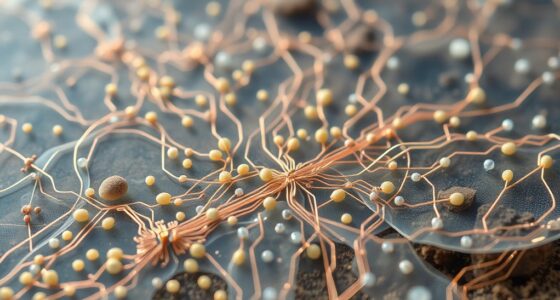Thermoelectric materials directly convert waste heat into electricity, helping you improve energy efficiency and harness thermal sources from engines, industrial processes, or the environment. By engineering nanostructures like nanoinclusions and superlattices, you can enhance their performance while maintaining stability at high temperatures. Careful design guarantees these materials stay durable over time, making them ideal for long-term energy harvesting. Keep exploring to discover how advancements in nanostructure optimization are transforming waste heat recovery.
Key Takeaways
- Thermoelectric materials convert waste heat directly into electricity through the Seebeck effect.
- Nanostructure engineering enhances thermoelectric efficiency by reducing thermal conductivity while maintaining electrical performance.
- Incorporating nanoinclusions, superlattices, and grain boundary control optimizes heat-to-electricity conversion.
- Material stability at high temperatures ensures reliable long-term waste heat harvesting.
- Balancing nanostructure optimization with stability improves device durability and energy harvesting effectiveness.

Thermoelectric materials are substances that can directly convert heat into electricity and vice versa. This unique ability makes them incredibly valuable for capturing waste heat from engines, industrial processes, and even natural sources, transforming it into usable power. To maximize their efficiency, you need to focus on two critical aspects: nanostructure optimization and material stability. These factors directly influence how well a thermoelectric device performs and how long it lasts in real-world applications.
Optimizing nanostructure and ensuring stability are key to efficient, durable thermoelectric devices.
Nanostructure optimization involves engineering the material at the nanoscale to enhance its thermoelectric properties. By carefully controlling the size, shape, and distribution of nanostructures within the material, you can reduce thermal conductivity without compromising electrical conductivity. This balance is essential because it allows heat to flow through the material effectively while preventing it from dissipating too quickly. Techniques like introducing nanoinclusions, creating superlattice structures, or adjusting grain boundaries help scatter phonons—the main carriers of heat—thus improving the overall thermoelectric efficiency. Additionally, researchers are exploring novel nanostructure engineering methods to further improve performance.
When you optimize the nanostructure, you fundamentally fine-tune the material’s internal pathways to favor electricity generation from heat. Additionally, ongoing research focuses on developing new high-performance materials that can better withstand operational stresses, further advancing thermoelectric technology.
Material stability is equally vital, especially when these materials are exposed to high temperatures and harsh environments. If your thermoelectric material degrades or reacts over time, its performance drops, and it becomes unreliable. Ensuring stability involves selecting or developing materials that can withstand thermal cycling, oxidation, and mechanical stress. For example, incorporating robust compounds or protective coatings can shield sensitive components from environmental damage.
When you prioritize material stability, you extend the lifespan of your thermoelectric devices, making them more practical for industrial and commercial use. Stable materials also maintain their optimized nanostructure over time, ensuring consistent performance.
Balancing nanostructure optimization with material stability might seem challenging, but it’s essential for creating effective thermoelectric systems. If your nanostructures aren’t stable, they can coarsen or degrade, diminishing efficiency. Conversely, overly stable materials might lack the nanostructural features necessary for high performance.
The key is to develop materials that sustain their nanoscale features under operational conditions while maintaining durability. When you achieve this balance, you create thermoelectric devices that aren’t only efficient but also reliable and long-lasting. This combination opens the door to the full potential of thermoelectrics in energy harvesting, helping you turn waste heat into a sustainable power source.
Frequently Asked Questions
How Do Thermoelectric Materials Perform at Extremely High Temperatures?
You might wonder how thermoelectric materials perform at extremely high temperatures. They generally face challenges like reduced efficiency due to decreased high temperature stability and increased phonon scattering.
However, advanced materials are designed to withstand these conditions, maintaining their properties. By controlling phonon scattering, these materials can improve performance, making them suitable for high-temperature applications.
This ongoing research aims to optimize thermoelectrics for extreme environments.
What Are the Environmental Impacts of Producing Thermoelectric Materials?
Imagine uncovering the true cost behind the devices you use daily. Producing thermoelectric materials impacts the environment through resource extraction, which can harm ecosystems and deplete natural reserves.
The environmental footprint isn’t just about energy; it’s about the raw materials and chemicals involved. You should consider how sustainable practices and recycling can reduce these impacts, making thermoelectric technology greener and more responsible for our planet’s future.
Can Thermoelectric Technology Be Integrated Into Existing Power Systems Easily?
You might wonder if thermoelectric technology can be integrated into existing power systems easily. While it offers promising benefits, integration challenges exist, mainly related to system compatibility and optimizing efficiency.
You’ll need to take into account how thermoelectric modules fit with current infrastructure, manage thermal gradients effectively, and ensure reliable operation.
Overcoming these challenges requires careful planning, but the potential for energy recovery makes it a worthwhile pursuit.
What Advancements Are Needed to Improve Thermoelectric Efficiency?
Like Icarus reaching for the sun, you need to push thermoelectric efficiency higher. To do so, you must focus on developing materials with greater durability and stability, especially under harsh conditions.
Additionally, advancing manufacturing scalability guarantees cost-effective production.
Improving these areas will help maximize energy conversion, making thermoelectric technology more practical and widespread, ultimately transforming waste heat into a reliable power source in various industries.
How Cost-Effective Are Thermoelectric Devices for Large-Scale Energy Harvesting?
You might wonder about the economic viability of thermoelectric devices for large-scale energy harvesting. Currently, their cost-effectiveness depends on manufacturing costs and efficiency improvements.
While they can be promising for waste heat recovery, high manufacturing expenses limit widespread use. To make them truly viable, you’ll need to see reductions in production costs and enhancements in efficiency.
This would make large-scale deployment more affordable and practical for energy harvesting applications.
Conclusion
So, here you are, relying on waste heat to power your world, thinking it’s a simple fix. It’s ironic, really—using what we once discarded to energize our lives. Thermoelectric materials promise a greener future, yet they still depend on the very heat we ignore. Maybe, just maybe, the real power lies in changing how we see waste—not just harvesting it. After all, sustainability begins when we stop throwing away what could truly energize us.









